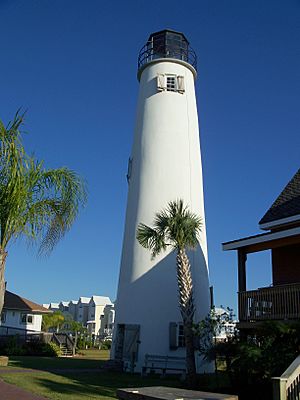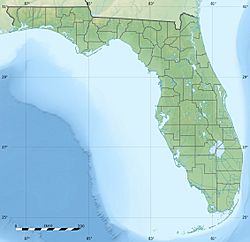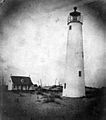Cape St. George Light facts for kids
 |
|
| Cape St. George Lighthouse (2010) | |
|
|
|
| Location | St. George Island Florida United States |
|---|---|
| Coordinates | 29°35′15.2″N 85°02′49.32″W / 29.587556°N 85.0470333°W |
| Year first constructed | 1833 (first) 1848 (second) 1852 (third) |
| Year first lit | 2009 (rebuilt and relocated) |
| Automated | 1949 |
| Deactivated | 1994–2009 |
| Foundation | stone basement |
| Construction | brick tower |
| Tower shape | tapered cylindrical tower with balcony and lantern |
| Markings / pattern | white tower, black lantern |
| Height | 70 feet (21 m) (current) 72 feet (22 m) (as of 1932) |
| Focal height | 76 feet (23 m) |
| Original lens | Third order Fresnel lens |
| ARLHS number | USA-140 |
| USCG number | 4-0075 |
The Cape St. George Light is a 72-foot-tall brick lighthouse that stood for 153 years on St. George Island, Florida. In 2005, it fell into the Gulf of Mexico. But don't worry, the pieces were saved! In 2008, the lighthouse was rebuilt and now stands proudly in a new, safer spot.
Contents
History of the Cape St. George Light
The Cape St. George Light has a long and interesting history, with several versions built over the years.
The First Lighthouse (1833)
The very first lighthouse on St. George Island was built in 1833. It was located near the western tip of the island. Its job was to guide ships through the narrow entrance to Apalachicola Bay. At that time, Apalachicola was a very busy port for shipping cotton.
This first tower was 65 feet (20 meters) tall. It had 13 lamps with special reflectors to make the light bright.
The Second Lighthouse (1848)
Ships coming from the eastern Gulf of Mexico had trouble seeing the first lighthouse. This was because of a sharp curve in the island's coast. So, in 1847, the government decided to build a new lighthouse. This new one would be about 2 miles southeast, closer to the cape.
Workers used materials from the old tower to build the new one in 1847–48. However, it was built on a very shallow foundation, only 18 inches deep. A big storm in 1850 weakened it. Then, another powerful storm in August 1851 knocked the tower down. Other lighthouses nearby were also destroyed by this storm.
The Third Lighthouse (1852)
The Cape St. George lighthouse was rebuilt quickly in 1851–52. This time, it was moved 250 yards inland from its old spot. To speed things up, two-thirds of the bricks from the fallen tower were reused.
This third lighthouse was built on a much stronger foundation. It had pine poles driven deep into the sand. The walls were very thick at the bottom (4 feet) and got thinner towards the top (2 feet). It used a special Fresnel lens that made its light visible up to 15 nautical miles (about 17 miles) out at sea.
Challenges and Changes
During the American Civil War, the lighthouse lens and other parts were removed for safety. They were hidden inland. When the war ended, the lens was found and put back. However, it was damaged and had a "dark angle," so it was replaced in 1899.
In 1878, a tropical storm damaged the tower and other buildings around it. Over the years, the light's power source changed. It switched to mineral oil in 1882 and then to incandescent oil vapor in 1913. In 1949, the light became automated, meaning it no longer needed a keeper to operate it. The Coast Guard stopped using the lighthouse in 1994.
The Collapse (2005)
Nature continued to challenge the lighthouse. In 1995, Hurricane Opal washed away a lot of sand around the tower. This caused it to lean about 10 degrees. In 1998, Hurricane Georges damaged it even more.
People in the community worked hard to save it. They raised money to fix the lean and build a new foundation in 2002. But the base of the lighthouse was still too close to the ocean waves. The new foundation started to wear away. Finally, on October 22, 2005, the tower collapsed into the water.
Rebuilding the Lighthouse
After the collapse, local volunteers formed the St. George Light Association. Their goal was to rebuild the lighthouse in a safer place. A special company helped retrieve 24,000 of the lighthouse's 160,000 bricks from the water. Volunteers then carefully cleaned each brick.
The Association received grants of $525,000 from federal and state sources. Local builders helped by offering their services at a lower cost. The salvaged bricks were used for the inside walls of the new tower. In April 2008, the restored top part of the lighthouse (the lantern room) was placed on top. The rebuilt lighthouse officially opened to the public on November 29, 2008. It now stands in a county park in the middle of St. George Island, safe from the waves.
Head Keepers
These are some of the people who were in charge of keeping the Cape St. George Light burning brightly:
- John W. Smith (1834)
- Allen Smith (1834–1835)
- John Garrison (1835)
- Willis Nichols (1835–1841)
- Saunders J. Nichols (1841)
- Samuel Parker (1841–1842)
- David Adkins (1842–1846)
- William McKeon (1846–1848)
- Francis Lee (1848–1849)
- William H. Taylor (1849–1850)
- William Austin (1850–1854)
- Braddock Williams (1854–1861)
- James Reilly (1866–1867)
- Joseph Lucroft (1867–1868)
- Braddock Williams (1868–1874)
- Arad L. Williams (1874–1875)
- James A. Williams (1875–1893)
- Edward G. Porter (1893–1913)
- John F. Reese (1913–1917)
- David D. Silva (1917–1921)
- Walter A. Roberts, Jr. (1921)
- Clairmon Brooks (1921–1925)
- David D. Silva (1925–1932)
- Walter Andrew Roberts, Jr. (1932–1938)
- Thorton K. Cooper (1938–1939)
- Sullivan R. White (1939–1946)
Gallery






